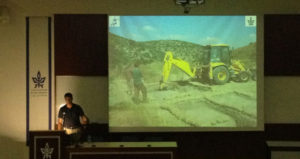Professor Yuval Goren: Criticism From An Unexpected Quarter
Professor Yuval Goren is known to readers of my blog for promoting “bulldozer archaeology” i.e., the idea that experts such as himself can excavate with a bulldozer or backhoe without damaging the archaeology. Goren has come under criticism from many quarters for his use of backhoes as archaeological tools. In the past, I’ve blogged several times (here and here) about Professor Goren’s methodology. Basically, I believe that the use of bulldozers and backhoes at an archaeological site is always wrong. Of course, bulldozers can be used to remove boulders and to clean up rubble outside the parameters of the actual dig. But one certainly shouldn’t use them – as Goren does and displays in the below picture – inside 5 by 5 meter excavation squares.

Recently, in the Open Journal of Geology, 4, 69-78, Rosenfeld, Feldman and Krumbein cited Goren’s work (p. 70) on the James Ossuary and then proceeded to totally contradict him. According to the authors, the results of their archaeometric analysis demonstrate that the controversial inscription is wholly authentic.
Now, Goren has come in for more professional criticism. The legendary Israeli archaeologist David Ussishkin writes in the latest issue of “Near Eastern Archaeology”, 77:1 (2014), 15-26, an in depth article on the Chalcolithic temple in Ein Gedi, 50 years after its discovery. Ussishkin believes that the Chalcolithic temple located high in the cliffs near the Ein Gedi spring is related to the Chalcolithic treasures found in a cave in Nahal Mishmar, about 10.5 KM from the Ein Gedi temple. The cave was excavated in 1961 and 1962 by Pesach Bar-Adon. In it, Bar-Adon found a Chalcolithic treasure hoard which contained 442 objects, including artifacts made of copper, 240 mace heads and various cultic objects. From the beginning, Ussishkin believed that the cult objects in the cave are the missing cult objects from Ein Gedi. He believes that, at some point long ago, the Ein Gedi priesthood abandoned the site and took their treasures with them. They hid their belongings in the cave, hoping one day to retrieve them. The scenario linking the Nahal Mishmar hoard with the Ein Gedi temple has been debated for years. Enter Professor Yuval Goren.
Goren does not subscribe to Ussishkin’s theory and has said so in numerous articles. The problem with the articles, as with his work on the James Ossuary, is that from article to article Goren uses the same facts to arrive at contradictory conclusions. Of course, an academic is entitled to change his mind, but Goren never lets on that that’s what he’s doing. Quite the contrary, he gives the impression that nothing has changed. In Professor Ussishkin’s words: “one would expect some explanations as to why he [Goren] has interpreted the same factual data in so markedly different ways”. With this statement, Professor Ussishkin returns Professor Goren to the limelight. Basically, by quoting Goren’s various pronouncements on the issue of Ein Gedi, Ussishkin demonstrates that Goren’s various conclusions make no sense. In Professor Ussishkin’s words: “in my view, this latest theory of Goren lacks any factual basis.” In a highly unusual move for colleagues at the same university, Ussishkin ends his article with a scathing critique of Goren: “one final remark, a look at Yuval Goren’s successive studies over the last 20 years…reveals their inconsistencies making it difficult to rely on them.”
Ussishkin’s critique is an important step in taking pseudo-academic bullying out of the world of academia. For decades, good scholars have run away from controversies and left the field to the bullies who use good PR and bad science to dominate the debates. As a result, Goren was able to have Golan dragged through the courts for a decade. Recently, Professor Karen King of Harvard Divinity School came out with an important Jesus related Coptic find. She was so thoroughly and personally attacked that she has basically been reduced to silence. In my case, Professor Robert Cargill went so far as to encourage his followers to physically beat me up because of my views that a burial cave in Talpiot belongs to Jesus of Nazareth and his family. When I called him out on this, Cargill said he meant that I should be beat up “metaphorically”.
But something new is in the air. As the opposition to Goren proves – the tide is turning. Good scholars and brave journalists are standing up to the defamers. They are doing so not by libelling but by opposing bad science with good science.
For more on fighting pseudo-academic bullying, see: http://www.simchajtv.com/bullying-exposed-a-pattern-of-defamation/
Check out my latest blog in the Times of Israel: Decoding the El Arish Stone – blog entry 1

